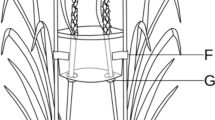Abstract
In recent years, Conogethes pluto (Lepidoptera: Crambidae) has become a major pest of Alpinia and other ornamental gingers in the Northern Territory and Queensland, Australia. This pest damages the flowers and bores into the stems, causing substantial losses to production. Currently, no synthetic sex pheromone is available to monitor or control this pest. This work aims at the identification of the sex pheromone of this pest. Analysis of the sex pheromone gland of female C. pluto by gas chromatography/electroantennogram detector revealed the presence of seven candidate pheromone compounds that elicited electroantennogram responses. Using gas chromatography/mass spectrometry analysis and micro-derivatization reactions, six compounds were identified as (E)-10-hexadecenal, as the main pheromone compound, (Z)-10-hexadecenal, hexadecanal, (E)-10-hexadecen-1-ol, (10E,12E)-hexadeca-10,12-dienal and (3Z,6Z,9Z)-tricosa-3,6,9-triene as minor pheromone compounds. In two-field trapping experiments, C. pluto responded to the six-component blend, and three of six compounds, i.e., (E)-10-hexadecenal, (3Z,6Z,9Z)-tricosa-3,6,9-triene, and (10E,12E)-hexadeca-10,12-dienal were shown to be necessary for attraction. In a subsequent experiment testing various doses (i.e., 0.01, 0.1, and 1 mg) of the six-component blend, the largest number of males was captured in traps baited with a lure loading of 1 mg. The availability of the sex pheromone of C. pluto will enable monitoring and provides the basis for additional control options for this pest.




Similar content being viewed by others
References
Adati T, Tatsuki S (1999) Identification of the female sex pheromone of the legume pod borer, Maruca vitrata and antagonistic effects of geometrical isomers. J Chem Ecol 25:105–115
Armstrong KF (2010) DNA barcoding: a new module in New Zealand’s plant biosecurity diagnostic toolbox. Eppo Bull 40:91–100
Arn H, Rauscher S, Guerin P, Buser H-R (1988) Sex pheromone blends of three tortricid pests in European vineyards. Agric Ecosyst Environ 21:111–117
Buser H, Arn H, Guerin P, Rauscher S (1983) Determination of double bond position in monounsaturated acetates by mass spectrometry of dimethyl disulfide adducts. Anal Chem 55:818–822
Clare G, Suckling DM, Bradley SJ, Walker JTS, Shaw PW, Daly JM, Mclaren GF, Wearing CH (2000) Pheromone trap colour determines catch of non-target insects. NZ Plant Prot 53:216–220
El-Sayed AM (2012) The Pherobase: database of insect pheromones and semiochemicals. http://www.pherobase.com. Accessed 15 Oct 2012
El-Sayed A, Goedde J, Witzgall P, Arn H (1999) Characterisation of pheromone blend for grapevine moth, Lobesia botrana by using flight track recording. J Chem Ecol 25:389–400
El-Sayed AM, Suckling DM, Wearing CH, Byers JA (2006) Potential of mass trapping for long-term pest management and eradication of invasive species. J Econ Entomol 99:1550–1564
El-Sayed AM, Suckling DM, Byers JA, Jang EB, Wearing CH (2009) Potential of “lure and kill” for long-term pest management and eradication of invasive species. J Econ Entomol 102:815–835
Gibb AR, Pinese B, Tenakanai D, Kawi AP, Bunn B, Ramankutty P, Suckling DM (2007) (Z)-11-Hexadecenal and (3Z,6Z,9Z)-tricosatriene: sex pheromone components of the red banded mango caterpillar Deanolis sublimbalis. J Chem Ecol 33:579–589
Kimura T (2002) Chemical ecology of sex pheromones in Conogethes sibling species. Doctoral Dissertation, University of Tsukuba (in Japanese)
Kondo A, Nagata K, Mochizuki F (2008) Geographical differences in pheromone trap performance in the yellow peach moth, Conogethes punctiferalis (Guenée) (Lepidoptera: Pyralidae) occurring in Japanese peach orchards. Jpn J Appl Entomol Zool Chugoku Branch 50:35–38
Konno Y, Arai K, Sekiguchi K, Matsumoto Y (1982) E)-10-Hexadecenal, a sex pheromone component of the yellow peach moth, Dichocrocis punctiferalis Guenée (Lepidoptera: Pyralidae). Appl Entomol Zool 17:207–217
Leonhardt BA, Devilbiss ED (1985) Separation and double-bond determination on nanogram quantities of aliphatic monounsaturated alcohols, aldehydes and carboxylic methyl esters. J Chromatogr 322:484Y490
Liu M, Tian Y, Li Y (1994) Identification of minor components of the sex pheromone of yellow peach moth, Dichorocis punctifeealis Guenée and field trials. Insect Sci 2:150–155
Marques FA, McElfresh JS, Millar JG (2000) Kováts retention indexes of monounsaturated C12, C14, and C16 alcohols, acetates, and aldehydes commonly found in lepidopteran pheromone blends. J Braz Chem Soc 11:592–599
Millar JG (2000) Polyene hydrocarbons and epoxides: a second major class of lepidopteran sex attractant pheromones. Annu Rev Entomol 45:575–604
Raina AK, Klun JA, Schwarz M, Day A, Leonhardt BA, Douglass LW (1986) Female sex pheromone of the melonworm, Diaphania hyalinata (Lepidoptera: Pyralidae), and analysis of male responses to pheromone in a flight tunnel. J Chem Ecol 12:229–237
Sas institute inc (1998) Statview. SAS Institute Inc., Cary
Scott PW (1995) Techniques and practice of chromatography. Marcel Dekker, New York
Stephenson BP, Gill GSC, Randall JL, Wilson JA (2003) Biosecurity approaches to surveillance and response for new plant pest species. NZ Plant Prot 56:5–9
Suckling DM (2000) Issues affecting the use of pheromones and other semiochemicals in orchards. Crop Prot 19:677–683
Xiao W, Honda H, Matsuyama S (2011) Monoenyl hydrocarbons in female body wax of the yellow peach moth as synergists of aldehyde pheromone components. Appl Entomol Zool 46:239–246
Acknowledgments
This work was supported by the New Zealand government (“Better Border Biosecurity”, www.B3nz.org) and Horticulture Australia Ltd (HAL). We thank two anonymous reviewers for their useful, detailed comments, many of which we believe have significantly improved the resubmitted paper. Andrew Twidle and John Byers for helpful comments on the manuscript and the growers for allowing us to conduct experiments in their properties in the Northern Territory, Australia.
Author information
Authors and Affiliations
Corresponding author
Rights and permissions
About this article
Cite this article
El-Sayed, A.M., Gibb, A.R., Mitchell, V.J. et al. Identification of the sex pheromone of Conogethes pluto: a pest of Alpinia. Chemoecology 23, 93–101 (2013). https://doi.org/10.1007/s00049-012-0123-9
Received:
Accepted:
Published:
Issue Date:
DOI: https://doi.org/10.1007/s00049-012-0123-9




